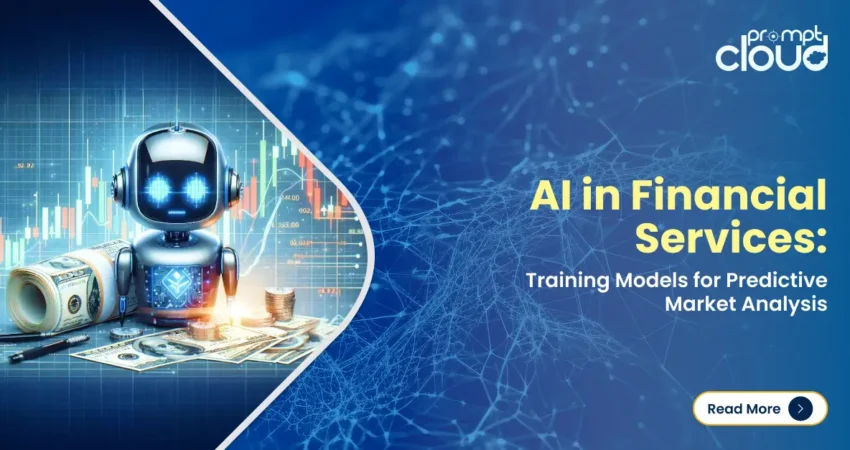
Artificial Intelligence (AI) is transforming industries, and few sectors have felt its impact as profoundly as finance. From detecting fraud to optimizing portfolios, AI in finance has become a critical tool for improving efficiency, reducing risks, and gaining a competitive edge. Among its most powerful applications is predictive market analysis, where AI models analyze vast datasets to anticipate trends, make informed decisions, and uncover opportunities.
This article explores how AI models are trained for predictive market analysis and the role data plays in driving innovation and precision in AI in finance.
Why AI in Finance is Becoming Indispensable?

The financial industry has always been data-intensive, relying on historical and real-time information to drive decisions. With AI, the ability to process, analyze, and act on this data has reached unprecedented levels. Predictive market analysis, powered by AI, is now enabling businesses to:
- Forecast stock prices and market trends with greater accuracy.
- Identify patterns and correlations that are invisible to human analysts.
- Adapt strategies in real-time based on shifting market conditions.
- Enhance customer experiences with personalized financial advice.
As AI in finance evolves, it continues to unlock new possibilities for growth, stability, and innovation.
How Predictive Market Analysis Works?
Predictive market analysis uses machine learning and AI algorithms to analyze data and predict future financial trends. The process involves:
- Data Collection: Gathering large-scale data from various sources, such as market feeds, social media sentiment, historical pricing, and global events.
- Feature Engineering: Identifying key variables or “features” that influence market behavior, such as interest rates, geopolitical events, or earnings reports.
- Model Training: Feeding the data into AI algorithms, such as neural networks or regression models, to learn patterns and relationships.
- Testing and Validation: Ensuring the model’s predictions are accurate by testing it against historical or unseen data.
- Deployment: Using the trained model for real-time predictions and decision-making.
This iterative process relies heavily on data quality, making the role of web scraping and advanced data collection methods indispensable for success.
What is The Role of Data in AI-Powered Predictive Market Analysis?
For AI in finance to deliver actionable insights, the quality and scope of data are paramount. Predictive market analysis requires:
1. Historical Data
- Includes past stock prices, trading volumes, and macroeconomic indicators.
- Helps AI models understand long-term patterns and correlations.
2. Real-Time Data
- Involves live feeds from markets, news outlets, and social media.
- Allows AI to make predictions based on the latest developments.
3. Alternative Data
- Non-traditional sources such as satellite imagery, web traffic, and sentiment analysis from reviews or tweets.
- Provides unique insights into market conditions that traditional datasets may miss.
4. Structured and Unstructured Data
- Structured data (e.g., stock prices in tables) is easily processed.
- Unstructured data (e.g., news articles, analyst opinions) requires Natural Language Processing (NLP) to extract insights.
With web scraping, financial institutions can gather this data at scale, enabling their AI models to operate with the depth and diversity needed for accurate predictions.
How AI-Powered Predictive Analysis Transforms Finance?
1. Stock Price Forecasting
AI models analyze historical prices, trading volumes, and external factors to predict future stock performance. Hedge funds and traders use these insights to optimize their portfolios and strategies.
2. Risk Management
By identifying patterns in market behavior, AI can detect early warning signs of volatility, enabling financial institutions to mitigate risks effectively.
3. Algorithmic Trading
Predictive models power algorithmic trading platforms that execute trades at lightning speed, taking advantage of small market inefficiencies for profit.
4. Sentiment Analysis
AI in finance leverages sentiment analysis tools to understand how public opinion impacts markets. For example, positive sentiment around a company can boost its stock price, while negative news can trigger sell-offs.
5. Portfolio Optimization
AI evaluates multiple asset classes and investment options, optimizing portfolios for maximum returns while balancing risks.
AI Training Challenges in Finance: Solutions & Strategies
While AI in finance offers immense potential, it also presents unique challenges:
1. Data Scarcity
Accessing high-quality, domain-specific data can be difficult. Many sources are proprietary or restricted, limiting training opportunities.
2. Data Noise
Financial data often contains noise—irrelevant or misleading information—that can skew model predictions.
3. Evolving Markets
Markets are dynamic, with factors like geopolitical shifts or policy changes altering conditions rapidly. AI models need regular retraining to remain effective.
4. Regulatory Compliance
Financial institutions must ensure that their data collection and model deployment comply with strict regulatory standards, such as GDPR or SEC guidelines.
5. Black-Box Nature
Complex AI models, like deep neural networks, can be difficult to interpret, making it challenging for analysts to trust predictions without transparency.
How Web Scraping Powers AI for Financial Insights?

Web scraping is a cornerstone technology for AI in finance, providing the data needed to train and refine predictive models. Its advantages include:
1. Large-Scale Data Collection
Automates the extraction of vast amounts of structured and unstructured data from diverse sources, ensuring models have the volume they need to perform well.
2. Real-Time Updates
Enables the collection of dynamic market data, keeping AI predictions relevant and actionable.
3. Diverse Sources
Scrapes data from news outlets, social media, financial reports, and more, providing a comprehensive view of market influences.
4. Customization
Tailors data collection to specific industries, asset classes, or geographic markets, ensuring relevance to the model’s objectives.
5. Improved Accuracy
By feeding models with fresh, diverse, and domain-specific data, web scraping reduces errors and enhances prediction reliability.
How PromptCloud Elevates AI Performance in the Financial Sector?
At PromptCloud, we specialize in helping financial institutions harness the power of data for AI. Our services include:
- Custom Web Scraping Solutions: Extracting data tailored to your predictive model’s needs.
- Scalable Data Pipelines: Handling high-volume, real-time data collection effortlessly.
- Regulatory Compliance: Ensuring ethical and compliant data practices.
- Comprehensive Data Feeds: Delivering structured and unstructured data from diverse sources like stock market feeds, global news, and sentiment analysis platforms.
Whether you’re building AI for predictive trading, portfolio management, or risk assessment, PromptCloud provides the tools and expertise to support your goals.
Conclusion:
As financial markets become more complex, AI’s role in delivering actionable insights will only grow. Predictive market analysis powered by AI models will continue to evolve, allowing institutions to stay ahead of trends, mitigate risks, and optimize strategies.
For finance businesses, embracing AI isn’t just about staying competitive—it’s about redefining what’s possible in a data-driven world. With robust data solutions like web scraping, the innovation journey becomes faster, smoother, and more impactful.
Ready to elevate your financial AI projects? Let PromptCloud help you unlock the power of data. Contact Us Today!



















